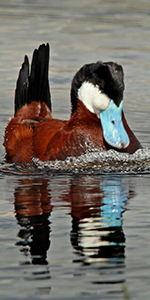| Ruddy Duck | ||
 |
Classification(s) : | Prey |
| Cat Name : | Duck | |
| Common Name : | Ruddy Duck | |
| Scientific Name : | Oxyura jamaicensis | |
| Other Name(s) : | ||
| Physical Description : | Male Ruddy Ducks have a white neck and lower face, and a black upper face back of neck. Their body is chestnut colored, and their tail is black. The underside is white and their beak is blue. During the winter, they are light brown. Female Ruddy Ducks are light brown during summer and winter. Both have a striking blue bill and a tail that faces upwards. |
|
| Physical Statistics : | Length: 14 – 17 Inches (35 – 43 Centimeters) |
|
| Behavior : | Ruddy Ducks live in marshes and nest on the ground. They are active during the day, and get their food by diving from the surface. |
|
| Social Organization : | Ruddy Ducks live in flocks and migrate south during the winter. |
|
| Approval Level : | None; Ruddy Ducks are common in marshlands. | |
| Kill Difficulty : | Moderate; Ruddy Ducks are large and able to deliver a strong buffet with thier wings that can break bone and rattle heads. |
|
| Training Level : | Specialty - Duck; A hunter must wait for the Ruddy Duck to come ashore, and Ruddy Ducks can also let out an alarm cry that makes prey flee. They can also fly away if startled. |
|
| Hunting Tactic : | Waterfowl | |
| Food Quality : | High; Ruddy Ducks are large enough to be shared amongst many cats and yield rich flesh. | |
